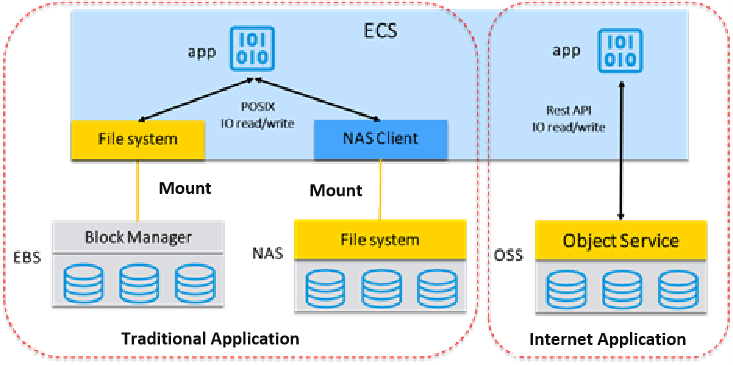This topic describes the differences between the following Alibaba Cloud storage services: File Storage NAS (NAS), Object Storage Service (OSS), and Elastic Block Storage (EBS). This topic also introduces the architecture for deploying these storage services for your applications.
Differences between NAS, OSS, and EBS
The following table describes the differences between File Storage NAS, Object Storage Service, and Elastic Block Storage.
Item | File Storage NAS | Object Storage Service | Elastic Block Storage |
Benefits | You can access a NAS file system the same way you access a local file system without the need to modify your application. NAS provides high throughput and high IOPS, and supports random read and write operations and online modification of files. | You can access OSS over the Internet. OSS provides a huge, low-cost, and shared storage space. If you do not need to frequently modify data after you write the data to OSS, we recommend that you store data by using OSS. | EBS provides storage at the data block level. EBS supports random read and write. You can use EBS devices as physical hard disks. You can partition and format EBS devices and create file systems for them. |
Scenarios | Data storage for scientific computing, container data persistence, and online production applications of enterprises. Examples: AI computing, gene computing, pharmaceutical computing, container sharing PVs, log data persistence, CI/CD platforms, and file sharing on cloud desktops. | Data storage for Internet applications that are developed based on object APIs. Examples: audio and video storage, data lakes, cloud photo albums for Internet services, and online storage for individual and enterprise users. | I/O-intensive applications that require high performance and low latency, such as online transactional processing (OLTP) and NoSQL databases. |
Access mode | Thousands of Elastic Compute Service (ECS) instances or tens of thousands of containers concurrently perform random read and write operations on a file over Portable Operating System Interface (POSIX). | Millions of clients concurrently perform read and append operations on an object by using SDKs and RESTful APIs. | EBS devices are bare disks. After an EBS device is attached to an ECS instance, you must format the device into a file system such as ext3, ext4, or NTFS before you can access the files stored on the device. If not more than 16 ECS instances access a disk at the same time, you must use cluster file systems such as Oracle Cluster File System version 2 (OCFS2), Global File System 2 (GFS2), Veritas Cluster File System (Veritas CFS), Oracle Automatic Storage Management Cluster File System (Oracle ACFS), and Databricks File System (DBFS) to ensure data synchronization among multiple instances. For more information, see Multi-attach for cloud disks. |
Minimum latency |
| Tens of milliseconds | A few microseconds |
Maximum throughput of a single instance | 20 GB/s | 2 to 100 Gbit/s The maximum throughput of uploads and downloads for a single Alibaba Cloud account varies in each region. For more information, see Limits and performance metrics. | A few GB per second |
Storage capacity | GiB~PiB | Unlimited | GiB~TiB |
File-level authorization | Supported | Supported | Not supported |
Data storage mode | Files are organized into directories. | All files are at the same directory level. | You must split data into arbitrarily divided volumes that have the same size. |
Protocol | NFS and SMB | HTTP and HTTPS | Standard virtual block device protocols or the Non-Volatile Memory Express (NVMe) protocol |
Architecture
The following figure shows the architecture for deploying File Storage NAS, Object Storage Service, and Elastic Block Storage for your applications.

References
File Storage NAS provides two storage classes: General-purpose NAS and Extreme NAS. For more information, see Storage Classes. For more information about how to select file systems based on your workloads, see Select file systems.
For more information about the billing of NAS, see Billing overview.